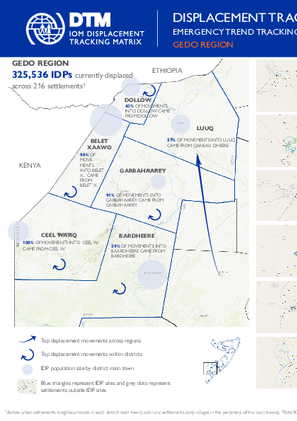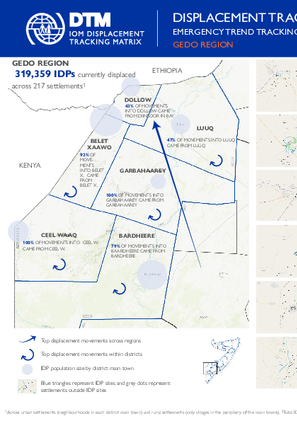-
Countries
-
Data and Analysis
-
Special Focus
-
Crisis Responses

Contact
iombeirut@iom.int
Language
English
Location
Lebanon
Period Covered
May 01 2022
Jul 31 2022
Activity
- Flow Monitoring
- Mobility Tracking
- Baseline Assessment
This snapshot summarizes available data on Sudanese nationals in Lebanon from IOM’s Migrant Presence Monitoring (MPM) Round 2. Data collection took place between May and July 2022. The MPM baseline assessment is designed to systematically assess, through a series of MPM Rounds, neighborhoods (admin level 4) in Lebanon to quantify the presence of migrants and support operational assistance, coordination, and planning. Data collection is based on estimations received from Key Informants who are mostly composed of migrant community representatives, Mukhtars - local authorities of these areas, and Municipality officials. A first round of data collection took place between October 2020 and June 2021.

Contact
iombeirut@iom.int
Language
English
Location
Lebanon
Period Covered
May 01 2022
Jul 31 2022
Activity
- Flow Monitoring
- Mobility Tracking
- Baseline Assessment
This snapshot summarizes available data on Ethiopian nationals from IOM’s Migrant Presence Monitoring (MPM) Round 2 Data collection took place between May and July 2022. The MPM baseline assessment is designed to systematically assess, through a series of MPM Rounds, neighborhoods (admin level 4) in Lebanon to quantify the presence of migrants and support operational assistance, coordination, and planning Data collection is based on estimations received from Key Informants who are mostly composed of migrant community representatives, Mukhtars local authorities of these areas, and Municipality officials A first round of data collection took place between October 2020 and June 2021.

Contact
DTM Nigeria, AllUsersInDTMNigeria@iom.int
Language
English
Location
Nigeria
Period Covered
Nov 01 2022
Nov 30 2022
Activity
- Flow Monitoring
- Event Tracking
As a component of the IOM's Displacement Tracking Matrix (DTM), the Transhumance Tracking Tool (TTT) Early Warning System, with support from community focal points and key informants, collects information on alerts relating to transhumance activities and movements in 5 Local Government Areas in Adamawa State (Demsa, Girei, Lamurde, Numan and Mayo-Belwa).
During this period, 248 alerts were recorded. These alerts consist of 230 events (93%) and 18 movements (7%). The reported events are instances that are related to agro-pastoral conflicts, inter and inter-community tensions, violent clashes, kidnapping for ransom, cattle rustling, robberies etc. Demsa and Lamurde LGA recorded the highest number of alerts occurred in at 27 per cent each, while Mayo-Belwa, Girei and Numan LGAs recorded 17, 15 and 14 per cent, respectively. Disaggregated data at the ward level suggested that Ndikong ward in Mayo-Belwa LGA and Nassarawo Demsa ward in Demsa LGA recorded a high number of 10 and 8 percent of the total alerts, respectively. Of the total alerts, 22 per cent resulted in casualties or injuries. None of the reported events resulted to population displacements.
Also identified from the November 2022 TTT early warning data, are potential areas that are related to transhumance, that are prone to conflicts. Some of these localities are in Demsa, Fufore, Girei, Lamurde, Mayo-Belwa, Numan, and Shelleng LGAs.

Contact
DTM Nigeria, AllUsersInDTMNigeria@iom.int
Language
English
Location
Nigeria
Snapshot Date
Nov 29 2022
Activity
- Mobility Tracking
- Event Tracking
On 29 November 2022, a fire outbreak was reported at Ajiri a host community location in Mafa LGA of Borno State. The fire damaged and destroyed shelters and belongings of numerous IDP households. Ajiri is one of the communities where IDPs from Farm Center Camp and Custom House 2 Camp (which were closed in September 2021) were relocated to by the state government.
The fire incident destroyed 157 emergency shelters, affecting a total of 826 individuals in 156 households. The affected individuals included 435 children, 217 women and 172 men.

Contact
DTM Somalia, IOMSomaliaDTM@iom.int
Language
English
Location
Somalia
Period Covered
Oct 29 2022
Nov 02 2022
Activity
- Mobility Tracking
- Event Tracking
Since November 2021, 325,888 individuals have been displaced by drought in Gedo region. Since round 34, an estimated 6,844 IDPs arrived at the assessed settlements.

Contact
DTM Somalia, IOMSomaliaDTM@iom.int
Language
English
Location
Somalia
Period Covered
Oct 22 2022
Oct 26 2022
Activity
- Mobility Tracking
- Event Tracking
Since November 2021, 319,359 individuals have been displaced by drought in Gedo region. Since round 33, an estimated 5,962 IDPs arrived at the assessed settlements.

Contact
rodakar-dataresearch@iom.int
Language
English
Location
The Gambia
Period Covered
Oct 01 2022
Oct 31 2022
Activity
- Flow Monitoring
IOM, through the Displacement Tracking Matrix (DTM) Flow Monitoring tool, collects data at key entry, exit and transit points to better understand population movements across West and Central Africa. The monitoring of population flows allows for the quantification and qualification of mobility flows and trends, migrant profiles, and migratory experiences and routes.
In The Gambia, DTM conducts Flow Monitoring activities at several important transit locations in:
1) Barra (FMPs are located at the ferry terminal and the main garage);
2) Farafenni (FMPs are located at Farafenni main garage, Farafenni Ballan-Ghar garage, Farafenni McCarthy and Sanjally garage, Farafenni turntable garage and the truck garage);
3) Basse (FMPs are situated at the main garage and the bus station in Basse Santa-Su) and
4) Brikama (FMPs are located at the main garage and the bus station).
These activities enable DTM to monitor the movements of passengers within, out of and towards The Gambia as well as the movements of those passengers transiting The Gambia. This report presents the key results of the Flow Monitoring Survey conducted from the 1st to the 31st of October 2022, excluding weekends and national holidays, with data collected for 22 days. The report presents data collected on flows, routes, departures, destinations and demographic profiles of travellers observed at the FMPs.

Contact
DTM Europe, DTMMediterranean@iom.int
Language
Bosnian, Croatian, Serbian
Location
Bosnia & Herzegovina
Snapshot Date
Oct 27 2022
Activity
- Migrants presence
- Mobility Tracking
27.10.2022. IOM u Bosni i Hercegovini (BiH) je u saradnji sa Službom za poslove sa strancima1 (SPS) i uz podršku Crvenog križa/krsta BiH (CKBiH) proveo šesnaestu zajedničku vježbu kako bi se prikupile informacije o broju migranata i tražilaca azila2 koji se trenutno nalaze u državi. Svrha ove redovne vježbe je da se pruži okvirni broj migrantske populacije koja nije smještena ili registrovana ni u jednom od privremenih prihvatnih centara (PPC) u bilo kojem trenutku.
Raspoređeno je ukupno 15 timova, sačinjenih od 33 popisivača (23 muškaraca, 10 žena), uz dodatnih 15 inspektora SPS-a (13 muškaraca, 2 žene) i 20 uposlenika CKBiH (12 muškaraca, 8 žena), u sedam kantona Federacije Bosne i Hercegovine (FBiH) i na 57 lokacija unutar entiteta Republika Srpska (RS).
Posjećena je ukupno 241 lokacija 3 u 53 različite općine. Timovi su u FBiH posjetili 75 lokacija u četiri općine Unsko-sanskog kantona (USK), 34 lokacije u šest općina Kantona Sarajevo (KS), 28 lokacija u deset općina Tuzlanskog kantona (TK), 37 lokacija u pet općina Hercegovačko-neretvanskog kantona (HNK), četiri lokacije u četiri općine Zapadno-hercegovačkog kantona (ZHK), četiri lokacije u jednoj općini Bosansko-podrinjskog Kantona-Goražde (BPK) i dvije lokacije u dvije općine u Kantonu 10. Timovi su u RS-u posjetili 13 lokacija u Zvorniku, sedam lokacija u Bijeljini, pet lokacija u Kozarskoj Dubici, po četiri lokacije u Bratuncu i Derventi, tri lokacije u Vlasenici, po dvije lokacije u Gradišci, Šamcu, Kostajnici, Novom Goraždu, Doboju i Rogatici, te po jednu
lokaciju u Banjojluci, Brodu, Novom Gradu, Milićima, Prijedoru, Srbcu, Vukosavlju i Sokocu (vidi Mapu na str.3).

Contact
DTM Europe, DTMMediterranean@iom.int
Language
English
Location
Bosnia & Herzegovina
Snapshot Date
Oct 27 2022
Activity
- Migrants presence
- Mobility Tracking
On 27 October 2022, the IOM conducted the 16th joint data collection exercise in Bosnia and Herzegovina (BiH) together with the Service for Foreigners’ Affairs1 (SFA) and the support of the Red Cross Society BiH (RCSBH). The purpose of this exercise is to collect information on the number of migrants and asylum-seekers2 present in the country as well as to provide an estimation of the migrant population currently not accommodated or registered in any official Temporary Reception Centre (TRC). The IOM deployed 15 teams consisting of 33 enumerators (23 male, 10 female) with the addition of 15 SFA staff (13 male, 2 female), 20 RCSBH staff (12 male, 8 female) in the seven Cantons of the Federation of Bosnia and Herzegovina (FBiH) and in 57 locations
across the Republic of Srpska (RS). In total, the teams visited 241 locations3 in 53 different municipalities. In FBiH, the teams visited 75 locations in four municipalities in Una-Sana Canton, 34 locations in six municipalities in Sarajevo Canton, 28 locations in ten municipalities in Tuzla Canton, 37 locations in five municipalities in Herzegovina – Neretva Canton, four locations in four municipalities in West Herzegovina Canton, four locations in one municipality in Bosnian Podrinje Goražde Canton, two locations in two municipalities in Canton 10. In RS, the teams visited 13 locations in Zvornik, seven locations in Bijeljina, five locations in Kozarska Dubica, four locations in each in Bratunac and Derventa, three locations in Vlasenica, two locations each in Gradiška,
Šamac, Kostajnica, Novo Goražde, Doboj and Rogatica, one location each in Banja Luka, Brod, Modriča, Novi Grad, Milići, Prijedor, Srbac, Vukosavlje and Sokolac (see Map on page 3).
Contact
DTM Libya, DTMLibya@iom.int
Language
English
Location
Libya
Snapshot Date
Nov 30 2022
Activity
- Mobility Tracking
- Site Assessment
Detention Centre Profiling is a component of IOM Libya’s Displacement Matrix programme. It is a data oriented tool that routinely provides specific sex and age demographic data and key sectorial information on individuals held in Libya’s detention centres on the date of assessment.
